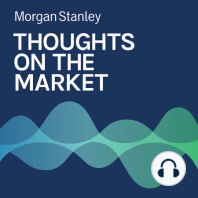3 min listen

How Immigration’s Rise Could Boost Economic Growth
How Immigration’s Rise Could Boost Economic Growth
ratings:
Length:
4 minutes
Released:
Apr 1, 2024
Format:
Podcast episode
Description
Our Global Chief Economist surveys recent US and Australian census data to explain immigration’s impact on labor supply and demand, as well as the implications for monetary policy. ----- Transcript -----Welcome to Thoughts on the Market. I'm Seth Carpenter, Morgan Stanley's Global Chief Economist, along with my colleagues bringing you a variety of perspectives. And today, I'll be talking about immigration, economic growth, and the implications for monetary policy.It's Monday, April 1st, at 10am in New York.Global migration is emerging as an important macro trend. Some migration patterns change during and after COVID, and such changes can have first order effects on the population and labor force of an economy.That fact has meant that several central banks have discussed immigration in the context of their economic outlook; and we focus here on the Fed and the Reserve Bank of Australia, the RBA.In the US, recent population estimates from the CBO and the census suggests that immigration has been and is still driving faster growth in the population and labor supply, helping to explain some of last year's upside surprise in non-farm perils. In Australia, the issue is even longer standing, and accelerated migration in recent years has provided important support to consumption and inflation.From a macro perspective, immigration can boost both aggregate demand and aggregate supply. More specifically, more immigration can lead to stronger consumption spending, a larger labor force, and may drive investment spending.The permanence of the immigration, like some immigrants are temporary students or just visiting workers, the skill level of the migrants and the speed of labor force integration are consequential -- in determining whether supply side or demand side effects dominate. Demand side effects tend to be more inflationary and supply side effects more disinflationary.In Australia, the acceleration in immigration has played an important driver in population growth and aggregate demand. In the decade before COVID, net migration added about a percentage point to the population growth annually. In 2022 and 2023, the growth rate accelerated beyond two percent. The pace of growth and migration and the type of migration have supported consumption spending and made housing demand outpace housing supply.Our Australia economists note that net migration will likely remain a tailwind for spending in 2024 -- but with significant uncertainty about the magnitude. In stark contrast, recent evidence in the US suggests that the surge in immigration has had a relatively stronger impact on aggregate supply. Growth in 2023 surprised to the upside, even relative to our rosier than consensus outlook.Academic research on US states suggests that over the period from 1970 to 2006, immigration tended to increase capital about one for one with increases in labor -- because the capital labor ratio in states receiving more immigrants remained relatively constant. That is, the inflow of immigrants stimulated an increase in investment.Of course, the sector of the economy that attracts the immigrants matters a lot. Immigrants joining sectors with lesser capital intensiveness may show less of this capital boosting effect.So, what are the implications for monetary policy? Decidedly, mixed. In the short run, more demand from any of the above sources will tend to be inflationary, and that suggests a higher policy rate is needed. But, as any supply boosting effects manifest, easier policy is called for to allow the economy to grow into that higher potential. So, a little bit here, a little bit there. Over the long run, though, only a persistently faster growth rate in immigration, as opposed to a one-off surge, would be able to raise the equilibrium rate, the so-called R star, on a permanent basis.Thanks for listening. If you enjoy the show, please leave us a review wherever you listen to podcasts and share Thoughts on the Market with a friend or a colleague today.
Released:
Apr 1, 2024
Format:
Podcast episode
Titles in the series (100)
Andrew Sheets: For Markets, Signs, Signs, Everywhere Signs by Thoughts on the Market